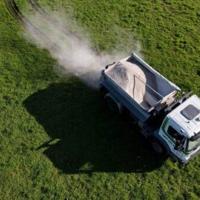According to a major study published on Wednesday, global emissions of nitrous oxide, a potent greenhouse gas, are surpassing expectations and endangering climate change goals.
The report, which drew on millions of atmospheric measurements from around the world, revealed a significant increase in human-related nitrous oxide levels.
Researchers expressed concerns that insufficient action is being taken to control the gas, with agriculture being the primary source of nitrous oxide production.
Scientists state that nitrous oxide heats the Earth’s atmosphere 300 times more effectively than carbon dioxide and can persist for over a century.
The Global Nitrous Oxide Budget, involving 58 international researchers, reported a 40 percent surge in emissions between the 1980s and 2020.
As a result, atmospheric nitrous oxide levels reached 336 parts per billion in 2022, representing a 25 percent increase from pre-industrial levels.
The lead author of the report, Hanqin Tian from Boston College, emphasized that nitrous oxide emissions must decrease to limit global warming to the Paris Agreement target of 2 degrees Celsius.
Tian mentioned, “Reducing nitrous oxide emissions is the only solution since at this point no technologies exist that can remove nitrous oxide from the atmosphere.”
Nitrous oxide, also known as laughing gas, is one of the three major greenhouse gases contributing to human-driven climate change, alongside carbon dioxide and methane.
It also contaminates the soil, water, and air, as well as depleting the ozone layer.
– Agriculture main culprit –
Agriculture was identified as the main source of nitrous oxide emissions, accounting for nearly three-quarters of human-related emissions in the decade leading up to 2020.
The report also implicated fossil fuels, waste and wastewater, and biomass burning as contributors to nitrous oxide emissions.
In the same period, agricultural emissions of nitrous oxide increased by 67 percent, primarily due to nitrogen-based fertilisers and animal waste.
While efforts are in place to reduce other greenhouse gases, nitrous oxide emissions continue to rise unchecked, according to Pep Canadell, co-leader of the study.
Canadell stressed the importance of taking more aggressive action to reduce nitrous oxide emissions, as current policies are inadequate.
The study highlighted that nitrous oxide accounts for 6.4 percent of total greenhouse gas emissions and is expected to grow in the future.
To keep global warming below 2 degrees Celsius, anthropogenic nitrous oxide emissions must decrease by approximately 20 percent by 2050.
– Farmers taking action –
The report identified China, India, the United States, Brazil, Russia, Pakistan, Australia, and Canada as the top nitrous oxide emitters, driven by population growth and increased demands in the food sector.
While Europe previously held this title, it managed to reduce emissions by decreasing fossil fuel usage, with agricultural emissions also on a slow decline.
Emissions in Japan and South Korea also saw a reduction.
Canadell noted that it may take up to a decade for new policies to limit nitrous oxide emissions to take effect, but many farmers are already adopting practices to decrease emissions, such as precise use of nitrogen fertilisers, genetic modification of crops, and sustainable farming practices.
Canadell stated, “If these emissions were to be reduced by whatever level, it will have a huge impact.”
lec/djw/mtp





